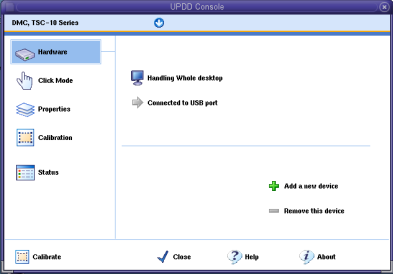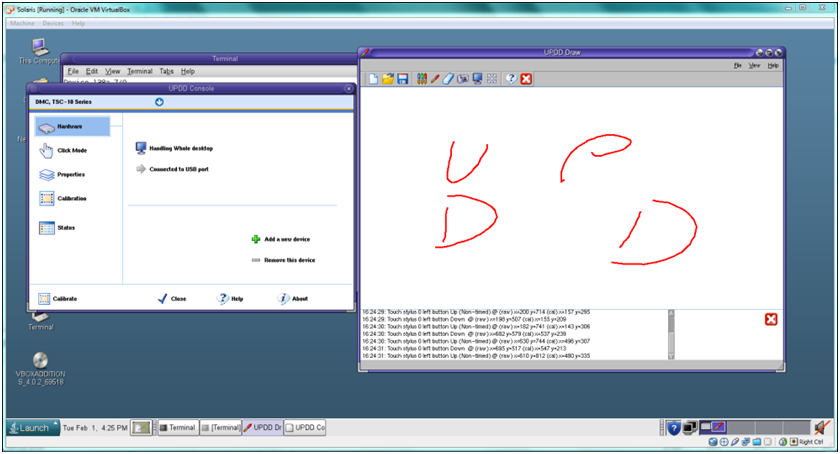|
|
|||||||
|
Welcome to UPDD Solaris platform specific installation instructions and related notes.
UPDD version 4.1.10 now supports the Solaris operating system on x86 hardware. Initial tests have been conducted with version 10 update 8.
These notes should be followed to install the UPDD pointer device driver on Solaris 10 platforms:
Driver build history
|
||||||||||||||||||||||||||||||||||||||||||||||||||||||||
DeliverablesThe software is delivered within a compressed file called upddsolx86.tgz and is normally downloaded from a HTTP download link as sent in an email.
|
||||||||||||||||||||||||||||||||||||||||||||||||||||||||
System Requirements
|
||||||||||||||||||||||||||||||||||||||||||||||||||||||||
InstallationNotes
ProceduresTo install the software unpack the supplied package to a working directory and run the script as root. E.g.
xhost + see important ‘Solaris service - xhost’ installation note above cd ~ mkdir updd cd updd cp <delivered package> . gunzip upddsolx86.tgz tar –xvf upddsolx86.tar sudo install_updd_sol.pl or depending on system configuration you might need to run sudo perl install_updd_sol.pl
The updd service is started automatically; there is no need to reboot. Installed modulesThis information is subject to change.
A number of package specific and optional links and files, such as help files will be included. These will be in /opt/tbupddso or one of its child folders. These files are not documented here. The following other files are installed:
UninstallTo uninstall the software execute the command
sudo /opt/tbupddso/uninstall_updd_sol.pl (or sudo perl /opt/tbupddso/uninstall_updd_sol.pl) Notes:
Using the supported programsDriverThe main driver process (tbupddwu) is installed and executed as a Solaris service. For full information about such services please consult the Solaris documentation. The following useful commands are noted here:
To stop the service: sudo svcadm disable tbupdd To start the service: sudo svcadm enable tbupdd To list information about the service: svcs –l tbupdd UtilitiesThe following support programs are located in /opt/tbupddso
There are no special requirements to run these programs. They can simply be launched from a terminal.
E.g. to run the UPDD Console to adjust settings
cd /opt/tbupddso dcu
or /opt/tbupddso/dcu
will show the Console dialog: (Note: In the current release some unsupported options are shown in the console.)
All the programs except dcu and tbutils are also available via appropriate options in the Console program.
A user is free to create a desktop shortcut to any of these utilities. As the method to do this depends on the desktop manager in use, please refer to the help for your desktop manager. CalibrationCalibration is a procedure used to align the pointer device with the graphically display area or desktop segment. When using the pointer device the mouse cursor should normally position itself under the stylus when it is in contact with the pointer device. If this is not the case then calibration will be required.
Current LimitationsUPDD was originally developed for Windows and has since been ported to other OS. When porting to other OS most key updd functionality is supported except where the functionality is OS specific or it is noted in the exclusions below.
The driver uses two background daemon processes, named tbdaemon and aidaemon, to implement some utility functionality. Options implemented by tbdaemon are not supported as there are no plans use tbdaemon in systems other than Windows desktop. Where appropriate individual features will be migrated to aidaemon (which is multi–platform ready). Aidaemon is NOT included in the current Solaris build. Features covered by aidaemon / tbdaemon are documented here, but includes features such as visual toolbars, event selector, toolbar actions, rotate, resolution monitoring and sound. Mouse EmulationThis driver does not currently perform desktop mouse emulation and to date has been used by applications using the UPDD API to receive touch data. Mouse emulation will be supported in the next release. ExclusionsThese are the key functions not currently ported to the Solaris environment
Screen shotWith the software correctly installed you should be able to run up the various UPDD utility programs to perform the required functions. In this example the UPDD Console and test program are shown on the desktop. The test program has been placed into Direct mode as this mode receives data directly via the API.
ContactFor further information or technical assistance please email the technical support team at technical@touch-base.com
|
||||||||||||||||||||||||||||||||||||||||||||||||||||||||

